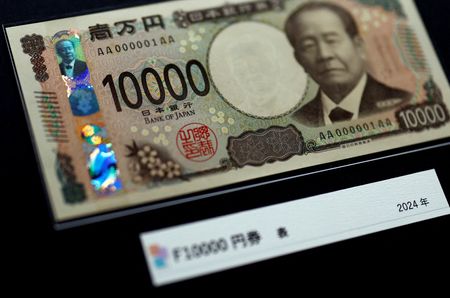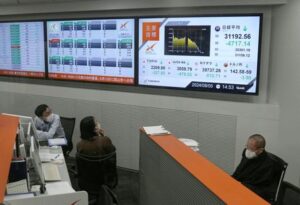By Vidya Ranganathan and Sruthi Shankar
SINGAPORE (Reuters) -Japan’s yen hit its highest levels against the dollar since January on Monday, as markets extended moves triggered last week by weak U.S. labour data that stoked recession worries and expectations of deeper rate cuts by the Federal Reserve.
Friday’s jobs data, coming on top of a string of weak earnings reports from large technology firms and heightened concerns over the Chinese economy, drove a global sell-off in stock markets, oil and high-yielding currencies as investors sought the safety of cash.
The selling continued on Monday, with U.S. Treasury yields falling further, stock indexes in the red, bitcoin dumped and the dollar losing ground, mainly to the yen.
The carry-funding favourite, the yen, strengthened as much as 3.4% to 141.675 per dollar at one point, before easing to 143.165. The currency was trading near its strongest level since early January.
The dollar dropped 0.5% against major currencies to trade at 102.62 – a near five-month low.
“Fears of a U.S. recession mean that the market is no longer looking for an orderly adjustment in Fed policy towards some kind of neutral rate – say near 3.25%. No, the fear of a recession is now bringing in the idea of stimulative monetary policy,” noted Chris Turner, head of FX strategy at ING.
“It is no surprise to see low-yielding currencies now in the ascendancy as the rest of the world now starts to converge on their low interest rates.”
The yen has jumped 14% against the dollar over the past three weeks, driven in part by the Bank of Japan’s 15-basis points rate rise last week to 0.25%, alongside which it announced a plan to halve its monthly bond purchases over the next couple of years.
Barclays analysts said the Japanese currency was the most overbought among G10 majors, and therefore “the bar for yet more outperformance in the near term appears high”.
The Swiss franc, another popular funding currency, was up more than 1% at 0.84825 to the dollar. The franc, a traditional safe haven, was also trading at a seven-month high.
High-yielding currencies such as the Indian rupee and Mexican peso tumbled, while currencies that had hitherto been used for funding investments, such as the yen and China’s yuan, rallied strongly.
Treasury yields have been falling quite sharply since last week, when the Federal Reserve kept the policy rate in its current 5.25% to 5.50% range while Chair Jerome Powell opened the possibility of a rate cut in September.
But by Friday, after data showed the unemployment rate had jumped, which sparked chatter the U.S. economy could be heading for a recession, expectations for rate cuts deepened.
Yields on 10-year U.S. Treasuries sank nearly 40 basis points last week, the largest weekly fall since March 2020, and were last at 3.75%.
Fed fund futures reflected traders pricing a near 99% chance of a 50 basis point cut at the central bank’s September meeting, according to LSEG data. Futures imply 127 basis points of cuts this year.
The euro was up 0.2% at $1.0954 despite the expectation for interest rate cuts from the European Central Bank (ECB) surging. Traders now see more than 90 basis points of rate cut from the ECB this year, versus 50 bps at the start of last week.
Meanwhile, markets are also dealing with the risk of military escalation in the Middle East after latest developments in the war between Israel and Hamas in Gaza, which has driven oil prices to their lowest since January.
The U.S. military is deploying more forces in the Middle East and Europe following threats from Iran and its allies Hamas and Hezbollah to respond to the killing of Hamas leader Ismail Haniyeh last week in Tehran.
(Reporting by Vidya Ranganathan in Singapore and Sruthi Shankar in Bengaluru; Editing by Christopher Cushing and Ros Russell)





